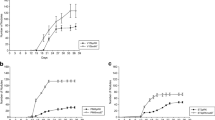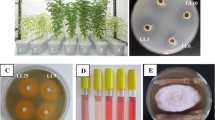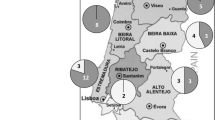Abstract
Aims
The main goal of the study reported herein was to assess the nodulation performance of a Mesorhizobium strain transformed with an exogenous ACC deaminase gene (acdS), and its subsequent ability to increase chickpea plant growth under normal and waterlogged conditions.
Methods
The Mesorhizobium ciceri strain LMS-1 was transformed with the acdS gene of Pseudomonas putida UW4 by triparental conjugation using plasmid pRKACC. A plant growth assay was conducted to verify the plant growth promotion ability of the LMS-1 (pRKACC) transformed strain under normal and waterlogging conditions. Bacterial ACC deaminase and nitrogenase activity was measured.
Results
By expressing the exogenous acdS gene, the transformed strain LMS-1 showed a 127% increased ability to nodulate chickpea and a 125% promotion of the growth of chickpea compared to the wild-type strain, under normal conditions. Plants inoculated with the LMS-1 wild-type strain showed a higher nodule number under waterlogging stress than under control conditions, suggesting that waterlogging increases nodulation in chickpea. No significant relationship was found between ACC deaminase and nitrogenase activity.
Conclusions
The results obtained in this study show that the use of rhizobial strains with improved ACC deaminase activity might be very important for developing microbial inocula for agricultural purposes.

Similar content being viewed by others
References
Abeles F, Morgan P, Saltveit M Jr (1992) Ethylene in plant biology, 2nd edn. Academic, New York
Alexandre A, Brígido C, Laranjo M, Rodrigues S, Oliveira S (2009) Survey of chickpea rhizobia diversity in Portugal reveals the predominance of species distinct from Mesorhizobium ciceri and Mesorhizobium mediterraneum. Microb Ecol 58(4):930–941
Banga M, Bogemann GM, Blom CWPM, Voesenek LACJ (1997) Flooding resistance of Rumex species strongly depends on their response to ethylene: Rapid shoot elongation or foliar senescence. Physiol Plantarum 99(3):415–422
Belimov AA, Safronova VI, Sergeyeva TA, Egorova TN, Matveyeva VA, Tsyganov VE, Borisov AY, Tikhonovich IA, Kluge C, Preisfeld A, Dietz KJ, Stepanok VV (2001) Characterization of plant growth promoting rhizobacteria isolated from polluted soils and containing 1-aminocyclopropane-1-carboxylate deaminase. Can J Microbiol 47(7):642–652
Beringer JE (1974) R factor transfer in Rhizobium leguminosarum. J Gen Microbiol 84:188–198
Bradford MM (1976) A rapid and sensitive method for the quantitation of microgram quantities of protein utilizing the principle of protein-dye binding. Anal Biochem 72:248–254
Bradford KJ, Dilley DR (1978) Effects of root anaerobiosis on ethylene production, epinasty, and growth of tomato plants. Plant Physiol 61(4):506–509
Bradford KJ, Hsiao TC, Yang SF (1982) Inhibition of ethylene synthesis in tomato plants subjected to anaerobic root stress. Plant Physiol 70(5):1503–1507
Broughton WJ, Dilworth MJ (1971) Control of leghaemoglobin synthesis in snake beans. Biochem J 125(4):1075–1080
Caba JM, Recalde L, Ligero F (1998) Nitrate-induced ethylene biosynthesis and the control of nodulation in alfalfa. Plant Cell Environ 21(1):87–93
Conforte VP, Echeverria M, Sanchez C, Ugalde RA, Menendez AB, Lepek VC (2010) Engineered ACC deaminase-expressing free-living cells of Mesorhizobium loti show increased nodulation efficiency and competitiveness on Lotus spp. J Gen Appl Microbiol 56(4):331–338
Cowie AL, Jessop RS, MacLeod DA (1996a) Effects of waterlogging on chickpeas.1. Influence of timing of waterlogging. Plant Soil 183(1):97–103
Cowie AL, Jessop RS, MacLeod DA (1996b) Effects of waterlogging on chickpeas.2. Possible causes of decreased tolerance of waterlogging at flowering. Plant Soil 183(1):105–115
Delgado MJ, Bedmar EJ, Downie JA (1998) Genes involved in the formation and assembly of rhizobial cytochromes and their role in symbiotic nitrogen fixation. Adv Microb Physiol 40:191–231
Duan J, Muller KM, Charles TC, Vesely S, Glick BR (2008) 1-aminocyclopropane-1-carboxylate (ACC) deaminase genes in rhizobia from southern Saskatchewan. Microb Ecol 57(3):423–436
Duarte I, De Sousa M, Pereira M, Carita T (1992) Duas novas cultivares de grão-de-bico para sementeira antecipada de Outono: ELMO e ELVAR. Pastagens e Forragens 13:125–134
Ferguson BJ, Indrasumunar A, Hayashi S, Lin MH, Lin YH, Reid DE, Gresshoff PM (2010) Molecular analysis of legume nodule development and autoregulation. J Integr Plant Biol 52(1):61–76
Finan TM, Kunkel B, Devos GF, Signer ER (1986) 2nd symbiotic megaplasmid in Rhizobium meliloti carrying exopolysaccharide and thiamine synthesis genes. J Bacteriol 167(1):66–72
Gage DJ (2004) Infection and invasion of roots by symbiotic, nitrogen−fixing rhizobia during nodulation of temperate legumes. Microbiol Mol Biol Rev 68(2):280–300
Gallacher A, Sprent J (1978) The effect of different water regimes on growth and nodule development of greenhouse−grown Vicia faba. J Exp Botany 29(2):413–423
Glick BR (2003) Phytoremediation: synergistic use of plants and bacteria to clean up the environment. Biotechnol Adv 21(5):383–393
Glick BR, Penrose DM, Li J (1998) A model for the lowering of plant ethylene concentrations by plant growth-promoting bacteria. J Theor Biol 190(1):63–68
Grichko VP, Glick BR (2001) Amelioration of flooding stress by ACC deaminase-containing plant growth-promoting bacteria. Plant Physiol Bioch 39(1):11–17
Guinel FC, Geil RD (2002) A model for the development of the rhizobial and arbuscular mycorrhizal symbioses in legumes and its use to understand the roles of ethylene in the establishment of these two symbioses. Can J Bot 80(7):695–720
Hong TD, Minchin FR, Summerfield RJ (1977) Recovery of nodulated cowpea plants (Vigna unguiculata (L.) Walp.) from waterlogging during vegetative growth. Plant Soil 48(3):661–672
Jackson MB (1985) Ethylene and responses of plants to soil waterlogging and submergence. Annu Rev Plant Phys 36:145–174
Jackson MB, Campbell DJ (1976) Waterlogging and petiole epinasty in tomato - role of ethylene and low oxygen. New Phytologist 76(1):21–29
Kozlowski TT (1984) Extent, causes, and impacts of flooding. In: Kozlowski TT (ed) Flooding and plant growth. Academic, New York, pp 1–5
Ma WB, Guinel FC, Glick BR (2003a) Rhizobium leguminosarum biovar viciae 1-aminocyclopropane-1-carboxylate deaminase promotes nodulation of pea plants. Appl Environ Micro 69(8):4396–4402
Ma WB, Sebestianova SB, Sebestian J, Burd GI, Guinel FC, Glick BR (2003b) Prevalence of 1-aminocyclopropane-1-carboxylate deaminase in Rhizobium spp. Anton Leeuw Int J G 83(3):285–291
Ma WB, Charles TC, Glick BR (2004) Expression of an exogenous 1-aminocyclopropane-1-carboxylate deaminase gene in Sinorhizobium meliloti increases its ability to nodulate alfalfa. Appl Environ Micro 70(10):5891–5897
Mayak S, Tirosh T, Glick BR (2004) Plant growth-promoting bacteria confer resistance in tomato plants to salt stress. Plant Physiol Biochem 42(6):565–572
Mesa S, Alche JD, Bedmar EJ, Delgado MJ (2004) Expression of nir, nor and nos denitrification genes from Bradyrhizobium japonicum in soybean root nodules. Physiol Plantarum 120(2):205–211
Miller JH (1972) Experiments in molecular genetics. Cold Spring Harbor Laboratory, Cold Spring Harbor, p 431
Minchin FR, Pate JS (1975) Effects of water, aeration, and salt regime on nitrogen-fixation in a nodulated legume—definition of an optimum root environment. J Exp Bot 26(90):60–69
Nukui N, Minamisawa K, Ayabe S, Aoki T (2006) Expression of the 1-aminocyclopropane-1-carboxylic acid deaminase gene requires symbiotic nitrogen-fixing regulator gene nifA2 in Mesorhizobium loti MAFF303099. Appl Environ Micro 72(7):4964–4969
Penrose DM, Glick BR (2003) Methods for isolating and characterizing ACC deaminase-containing plant growth-promoting rhizobacteria. Physiol Plantarum 118(1):10–15
Robertsen BK, Aman P, Darvill AG, Mcneil M, Albersheim P (1981) Host-Symbiont Interactions.5. The structure of acidic extracellular polysaccharides secreted by rhizobium leguminosarum and Rhizobium trifolii. Plant Physiol 67(3):389–400
Sambrook J, Russell DW (2001) Molecular cloning: a laboratory manual, 3rd edn. Cold Spring Harbor Laboratory Press, Cold Spring Harbor
Sanchez C, Tortosa G, Granados A, Delgado A, Bedmar EJ, Delgado MJ (2011) Involvement of Bradyrhizobium japonicum denitrification in symbiotic nitrogen fixation by soybean plants subjected to flooding. Soil Biol Biochem 43(1):212–217
Saxena M, Singh K (1987) The chickpea. CAB International, Wallingford
Schmidt JS, Harper JE, Hoffman TK, Bent AF (1999) Regulation of soybean nodulation independent of ethylene signaling. Plant Physiol 119(3):951–959
Schwinghamer MW (1994) Grower guide to identification of chickpea diseases in northern NSW. NSW Agriculture/Grains Research and Development Corporation, NSW
Shah S, Li JP, Moffatt BA, Glick BR (1998) Isolation and characterization of ACC deaminase genes from two different plant growth-promoting rhizobacteria. Can J Microbiol 44(9):833–843
Siddique KHM, Brinsmead RB, Knight R, Knights EJ, Paull JG, Rose IA (2000) Adaptation of chickpea (Cicer arietinum L.) and faba bean (Vicia faba L.) to Australia. In: Knight R (ed) Linking research and marketing opportunities for pulses in the 21st century, vol. 34. Current plant science and biotechnology in agriculture. Springer, Dordrecht, pp 289–303
Somasegaran P, Hoben H (1994) Handbook for rhizobia. Springer, New York
Sprent JI (1972) Effects of water stress on nitrogen-fixing root nodules.4. Effects on whole plants of vicia faba and glycine max. New Phytol 71(4):603–611
Uchiumi T, Ohwada T, Itakura M, Mitsui H, Nukui N, Dawadi P, Kaneko T, Tabata S, Yokoyama T, Tejima K, Saeki K, Omori H, Hayashi M, Maekawa T, Sriprang R, Murooka Y, Tajima S, Simomura K, Nomura M, Suzuki A, Shimoda Y, Sioya K, Abe M, Minamisawa K (2004) Expression islands clustered on the symbiosis island of the Mesorhizobium loti genome. J Bacteriol 186(8):2439–2448
Vartapetian BB, Jackson MB (1997) Plant adaptations to anaerobic stress. Ann Bot-London 79(suppl 1):3–20
Wang TW, Arteca RN (1992) Effects of low O2 root stress on ethylene biosynthesis in tomato plants (Lycopersicon esculentum Mill cv Heinz 1350). Plant Physiol 98(1):97–100
Acknowledgments
The research leading to these results has received funding from Fundação para a Ciência e a Tecnologia (FCT) and co-financed by FEDER (PTDC/BIO/80932/2006) and from the European Union Seventh Framework Programme (FP7/2007-2013) under grant agreement n° 247669. C. Brígido acknowledges a FCT fellowship (SFRH/BD/30680/2006). The authors thank G. Mariano for technical assistance. Chickpea seeds were generously provided by the Instituto Nacional de Recursos Biológicos, Elvas, Portugal.
Author information
Authors and Affiliations
Corresponding author
Additional information
Responsible Editor: Harsh P. Bais.
Rights and permissions
About this article
Cite this article
Nascimento, F., Brígido, C., Alho, L. et al. Enhanced chickpea growth-promotion ability of a Mesorhizobium strain expressing an exogenous ACC deaminase gene. Plant Soil 353, 221–230 (2012). https://doi.org/10.1007/s11104-011-1025-2
Received:
Accepted:
Published:
Issue Date:
DOI: https://doi.org/10.1007/s11104-011-1025-2




